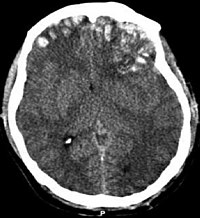
Photo from wikipedia
BACKGROUND Trauma is one of the major causes of morbidity and mortality globally, especially in younger populations. With an increase in obesity globally, it is important to assess the potential… Click to show full abstract
BACKGROUND Trauma is one of the major causes of morbidity and mortality globally, especially in younger populations. With an increase in obesity globally, it is important to assess the potential differences in injury pattern and management of obese patients presenting with trauma compared to lean patients to try and improve patient care. This study aims to review the available literature comparing injury patterns between obese and non-obese patients. METHODS A systematic review of articles which assessed the association between obesity and different patterns of trauma and injury were assessed. Study quality was assessed using the Newcastle-Ottawa Scale. Data for injury patterns, type of trauma and patient course and outcome including length of ITU stay, length of intubation, length of hospital stay and mortality were collected. Summary data was assessed with random-effects meta-analysis. RESULTS 21 studies with a total of 2,977,758 patients were identified. The majority of included patients had suffered blunt trauma. Lean patients were found to have a slightly increased risk of blunt trauma as a mechanism of injury (RR 1.02 p=<0.001), with a greater risk of head injury (lean patients RR 1.38 p=<0.001), reduced likelihood of extremity (lean RR 0.79 p=<0.001), and thoracic injury (lean RR 0.83 p = 0.002). There was no difference in risk of abdominal injury (p = 0.39). DISCUSSION Obese trauma patients present with different injury patterns compared to lean patients. This may have significant impact on resource requirements and patient outcomes and must be considered when planning or allocating resources for trauma care. Whether differing injury patterns relate to body habitus, lifestyle factors, or other confounders is unclear, but likely represents a combination of thereof.
Journal Title: International journal of surgery
Year Published: 2018
Link to full text (if available)
Share on Social Media: Sign Up to like & get
recommendations!